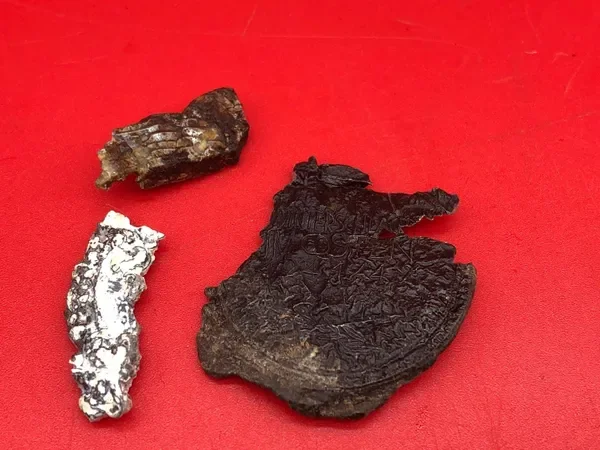 Image 1 of 6
Image 1 of 6

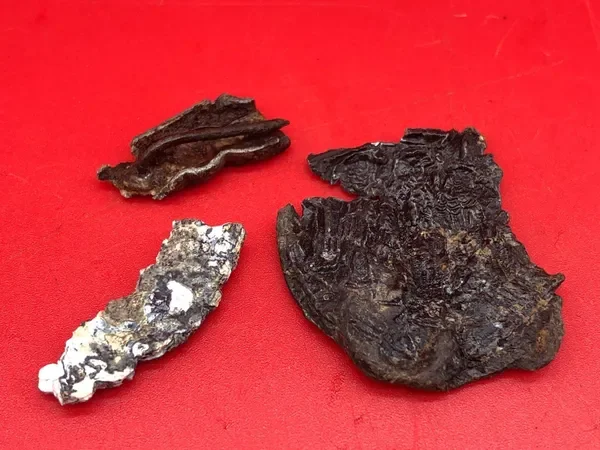 Image 2 of 6
Image 2 of 6

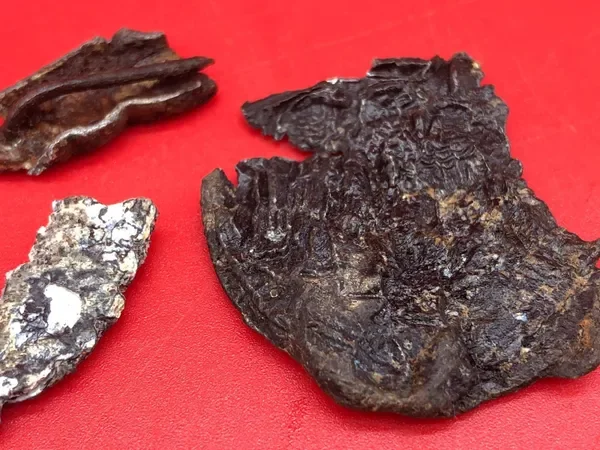 Image 3 of 6
Image 3 of 6

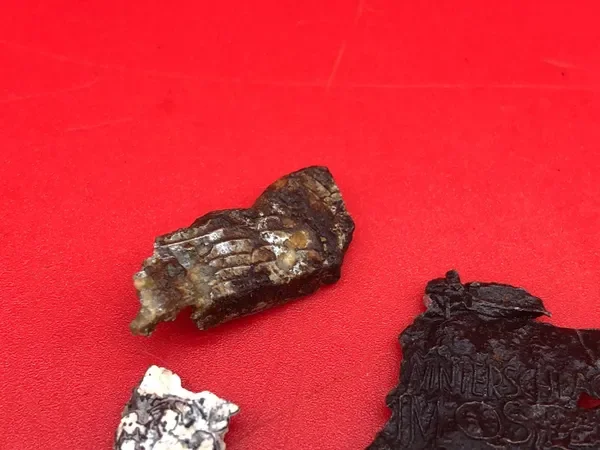 Image 4 of 6
Image 4 of 6

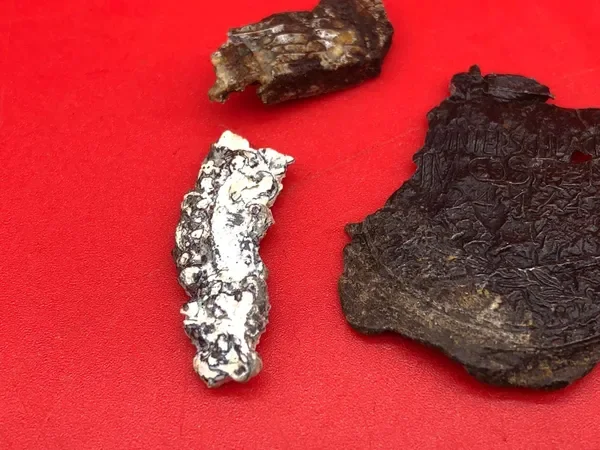 Image 5 of 6
Image 5 of 6

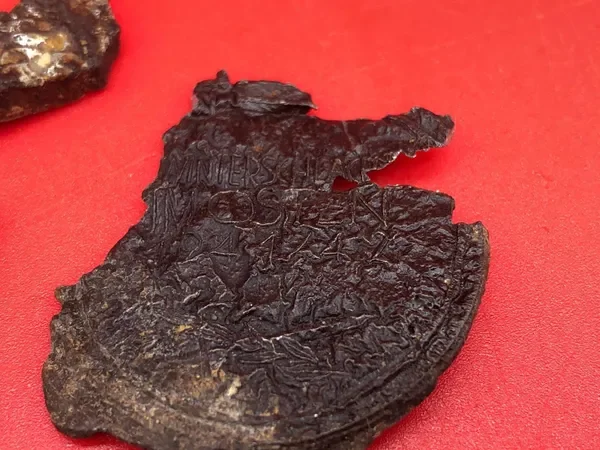 Image 6 of 6
Image 6 of 6







Group of medal parts which are the outer ring wreath, wing from cap eagle and Eastern front medal recovered from Osweiler in the Ardennes Forest 1944
This is a very nice set of medal parts, including an outer ring wreath, a wing from a cap eagle, and remains of an Eastern Front medal. Some of the original markings are still visible. The pieces are in relic but solid condition and retain much of their original colour. They show minor damage from being buried, have been carefully cleaned, and are perfect for display or any collection. The badge remains were recovered from a rubbish pit near the town of Osweiler in Luxembourg, likely dug either by German forces during the battle or during battlefield clearance afterwards. This area was attacked by the German 212th Volksgrenadier Division during the Battle of the Bulge in the winter of 1944-1945, part of the Ardennes Offensive and Hitler’s last major offensive in the West.
The 212th Infantry Division was raised in August 1939 and remained on garrison duty in Germany until March 1941, when it served three months as a coastal defence unit along the English Channel. In November 1941, it was transferred to the Eastern Front, joining Army Group North near Leningrad and along the Volkhov front. It remained with Army Group North until summer 1944, when it had been pushed back to Lithuania and was transferred to Army Group Centre. The division was destroyed there in August or September 1944, and survivors were reconstituted as the 578th Volksgrenadier Division, which was almost immediately renamed the 212th Volksgrenadier Division in October 1944.
On the Western Front, the division suffered heavy losses during the Battle of the Bulge and at the Siegfried Line, ultimately surrendering to US forces at the end of the war. In November 1944, the 212th Volksgrenadier Division moved west to join the Seventh Army across the Sauer from Echternach, under the command of Generalleutnant Franz Sensfuss. It was at full strength with high morale, but like many Volksgrenadier divisions, it had limited armoured support just five StuG assault guns and only two of its three infantry regiments were available at the start of the Ardennes Offensive.
The initial attacks on 16 December 1944 advanced from Echternach toward Berdorf, Dickweiler, and Osweiler, catching the US 4th Infantry Division by surprise. Echternach was captured on 17 December after Sensfuss personally led an assault by the 212th Fusilier Battalion. Berdorf was also taken the same day, forcing a US 10th Armoured Division task force out after bitter fighting. As more units of Patton’s US Third Army arrived, the Volksgrenadiers shifted to defence. They held their gains but were eventually forced to retire, returning to their starting positions by the end of January 1945.
This is a very nice set of medal parts, including an outer ring wreath, a wing from a cap eagle, and remains of an Eastern Front medal. Some of the original markings are still visible. The pieces are in relic but solid condition and retain much of their original colour. They show minor damage from being buried, have been carefully cleaned, and are perfect for display or any collection. The badge remains were recovered from a rubbish pit near the town of Osweiler in Luxembourg, likely dug either by German forces during the battle or during battlefield clearance afterwards. This area was attacked by the German 212th Volksgrenadier Division during the Battle of the Bulge in the winter of 1944-1945, part of the Ardennes Offensive and Hitler’s last major offensive in the West.
The 212th Infantry Division was raised in August 1939 and remained on garrison duty in Germany until March 1941, when it served three months as a coastal defence unit along the English Channel. In November 1941, it was transferred to the Eastern Front, joining Army Group North near Leningrad and along the Volkhov front. It remained with Army Group North until summer 1944, when it had been pushed back to Lithuania and was transferred to Army Group Centre. The division was destroyed there in August or September 1944, and survivors were reconstituted as the 578th Volksgrenadier Division, which was almost immediately renamed the 212th Volksgrenadier Division in October 1944.
On the Western Front, the division suffered heavy losses during the Battle of the Bulge and at the Siegfried Line, ultimately surrendering to US forces at the end of the war. In November 1944, the 212th Volksgrenadier Division moved west to join the Seventh Army across the Sauer from Echternach, under the command of Generalleutnant Franz Sensfuss. It was at full strength with high morale, but like many Volksgrenadier divisions, it had limited armoured support just five StuG assault guns and only two of its three infantry regiments were available at the start of the Ardennes Offensive.
The initial attacks on 16 December 1944 advanced from Echternach toward Berdorf, Dickweiler, and Osweiler, catching the US 4th Infantry Division by surprise. Echternach was captured on 17 December after Sensfuss personally led an assault by the 212th Fusilier Battalion. Berdorf was also taken the same day, forcing a US 10th Armoured Division task force out after bitter fighting. As more units of Patton’s US Third Army arrived, the Volksgrenadiers shifted to defence. They held their gains but were eventually forced to retire, returning to their starting positions by the end of January 1945.
